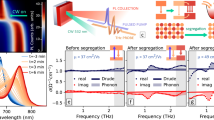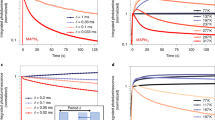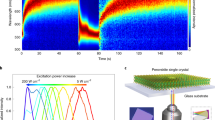Abstract
Metal halide perovskites have emerged as exceptional semiconductors for optoelectronic applications. Substitution of the monovalent cations has advanced luminescence yields and device efficiencies. Here, we control the cation alloying to enhance optoelectronic performance through alteration of the charge carrier dynamics in mixed-halide perovskites. In contrast to single-halide perovskites, we find high luminescence yields for photoexcited carrier densities far below solar illumination conditions. Using time-resolved spectroscopy we show that the charge carrier recombination regime changes from second to first order within the first tens of nanoseconds after excitation. Supported by microscale mapping of the optical bandgap, electrically gated transport measurements and first-principles calculations, we demonstrate that spatially varying energetic disorder in the electronic states causes local charge accumulation, creating p- and n-type photodoped regions, which unearths a strategy for efficient light emission at low charge-injection in solar cells and light-emitting diodes.
This is a preview of subscription content, access via your institution
Access options
Access Nature and 54 other Nature Portfolio journals
Get Nature+, our best-value online-access subscription
$29.99 / 30 days
cancel any time
Subscribe to this journal
Receive 12 print issues and online access
$209.00 per year
only $17.42 per issue
Buy this article
- Purchase on Springer Link
- Instant access to full article PDF
Prices may be subject to local taxes which are calculated during checkout




Similar content being viewed by others
Data availability
The data that support the plots within this paper and other findings of this study are available at the University of Cambridge Repository (https://doi.org/10.17863/CAM.43748).
References
Deschler, F. et al. High photoluminescence efficiency and optically pumped lasing in solution-processed mixed halide perovskite semiconductors. J. Phys. Chem. Lett. 5, 1421–1426 (2014).
Pazos-Outón, L. M. et al. Photon recycling in lead iodide perovskite solar cells. Science 351, 1430–1433 (2016).
Richter, J. M. et al. Enhancing photoluminescence yields in lead halide perovskites by photon recycling and light out-coupling. Nat. Commun. 7, 13941 (2016).
Pazos-Outón, L. M., Xiao, T. P. & Yablonovitch, E. Fundamental efficiency limit of lead iodide perovskite solar cells. J. Phys. Chem. Lett. 9, 1703–1711 (2018).
Stranks, S. D., Hoye, R. L. Z., Di, D., Friend, R. H. & Deschler, F. The physics of light emission in halide perovskite devices. Adv. Mater.1803336 (2018).
Best Research-Cell Efficiencies (NREL, accessed 09 September 2019); https://www.nrel.gov/pv/assets/pdfs/best-research-cell-efficiencies.20190802.pdf
Yang, W. S. et al. High-performance photovoltaic perovskite layers fabricated through intramolecular exchange. Science 348, 1234–1237 (2015).
Jacobsson, T. J. et al. Extending the compositional space of mixed lead halide perovskites by Cs, Rb, K, and Na doping. J. Phys. Chem. C 122, 13548–13557 (2018).
Li, W. et al. Chemically diverse and multifunctional hybrid organic–inorganic perovskites. Nat. Rev. Mater. 2, 16099 (2017).
Braly, I. L. et al. Hybrid perovskite films approaching the radiative limit with over 90% photoluminescence quantum efficiency. Nat. Photon. 12, 355–361 (2018).
Xiao, Z. et al. Efficient perovskite light-emitting diodes featuring nanometre-sized crystallites. Nat. Photon. 11, 108–115 (2017).
Yuan, M. et al. Perovskite energy funnels for efficient light-emitting diodes. Nat. Nanotechnol. 11, 872–877 (2016).
Gong, X. et al. Electron–phonon interaction in efficient perovskite blue emitters. Nat. Mater. 17, 550–556 (2018).
Liu, Y. et al. Efficient blue light-emitting diodes based on quantum-confined bromide perovskite nanostructures. Nat. Photon. 13, 760–764 (2019).
Tan, Z.-K. et al. Bright light-emitting diodes based on organometal halide perovskite. Nat. Nanotechnol. 9, 687–692 (2014).
Davies, C. L. et al. Bimolecular recombination in methylammonium lead triiodide perovskite is an inverse absorption process. Nat. Commun. 9, 293 (2018).
Hoke, E. T. et al. Reversible photo-induced trap formation in mixed-halide hybrid perovskites for photovoltaics. Chem. Sci. 6, 613–617 (2015).
Salado, M., Calio, L., Berger, R., Kazim, S. & Ahmad, S. Influence of the mixed organic cation ratio in lead iodide based perovskite on the performance of solar cells. Phys. Chem. Chem. Phys. 18, 27148–27157 (2016).
Pellet, N. et al. Mixed-organic-cation perovskite photovoltaics for enhanced solar-light harvesting. Angew. Chem. Int. Ed. 53, 3151–3157 (2014).
Jesper Jacobsson, T. et al. Exploration of the compositional space for mixed lead halogen perovskites for high efficiency solar cells. Energy Environ. Sci. 9, 1706–1724 (2016).
Saliba, M. et al. Cesium-containing triple cation perovskite solar cells: improved stability, reproducibility and high efficiency. Energy Environ. Sci. 9, 1989–1997 (2016).
Solanki, A. et al. Cation influence on carrier dynamics in perovskite solar cells. Nano Energy 58, 604–611 (2019).
Saliba, M. et al. Incorporation of rubidium cations into perovskite solar cells improves photovoltaic performance. Science 354, 206–209 (2016).
Abdi-Jalebi, M. et al. Maximizing and stabilizing luminescence from halide perovskites with potassium passivation. Nature 555, 497–501 (2018).
Jones, T. W. et al. Lattice strain causes non-radiative losses in halide perovskites. Energy Environ. Sci. 12, 596–606 (2019).
Milot, R. L., Eperon, G. E., Snaith, H. J., Johnston, M. B. & Herz, L. M. Temperature-dependent charge-carrier dynamics in CH3NH3PbI3 perovskite thin films. Adv. Funct. Mater. 25, 6218–6227 (2015).
Galkowski, K. et al. Determination of the exciton binding energy and effective masses for methylammonium and formamidinium lead tri-halide perovskite semiconductors. Energy Environ. Sci. 9, 962–970 (2016).
Tombe, S. et al. Optical and electronic properties of mixed halide (X = I, Cl, Br) methylammonium lead perovskite solar cells. J. Mater. Chem. C 5, 1714–1723 (2017).
Wehrenfennig, C., Liu, M., Snaith, H. J., Johnston, M. B. & Herz, L. M. Homogeneous emission line broadening in the organo lead halide perovskite CH3NH3PbI3-xClx. J. Phys. Chem. Lett. 5, 1300–1306 (2014).
Meggiolaro, D. et al. Iodine chemistry determines the defect tolerance of lead-halide perovskites. Energy Environ. Sci. 11, 702–713 (2018).
De Angelis, F. & Petrozza, A. Clues from defect photochemistry. Nat. Mater. 17, 383–384 (2018).
Herz, L. M. Charge-carrier mobilities in metal halide perovskites: fundamental mechanisms and limits. ACS Energy Lett. 2, 1539–1548 (2017).
Hu, Y. et al. Understanding the role of cesium and rubidium additives in perovskite solar cells: trap states, charge transport, and recombination. Adv. Energy Mater. 8, 1703057 (2018).
Sutter-Fella, C. M. et al. Cation-dependent light-induced halide demixing in hybrid organic-inorganic perovskites. Nano Lett. 18, 3473–3480 (2018).
Zhang, H. et al. Phase segregation due to ion migration in all-inorganic mixed-halide perovskite nanocrystals. Nat. Commun. 10, 1088 (2019).
Miller, O. D., Yablonovitch, E. & Kurtz, S. R. Strong internal and external luminescence as solar cells approach the Shockley–Queisser limit. IEEE J. Photovoltaics 2, 303–311 (2012).
Spear, W. E. & Le Comber, P. G. Substitutional doping of amorphous silicon. Solid State Commun. 17, 1193–1196 (1975).
Endres, J. et al. Valence and conduction band densities of states of metal halide perovskites: a combined experimental-theoretical study. J. Phys. Chem. Lett. 7, 2722–2729 (2016).
Schulz, P. et al. Interface energetics in organo-metal halide perovskite-based photovoltaic cells. Energy Environ. Sci. 7, 1377–1381 (2014).
Cho, H. et al. Overcoming the electroluminescence efficiency limitations of perovskite light-emitting diodes. Science 350, 1222–1225 (2015).
Yang, X. et al. Efficient green light-emitting diodes based on quasi-two-dimensional composition and phase engineered perovskite with surface passivation. Nat. Commun. 9, 570 (2018).
Cardenas-Daw, C., Simon, T., Stolarczyk, J. K. & Feldmann, J. Migration of constituent protons in hybrid organic-inorganic perovskite triggers intrinsic doping. J. Am. Chem. Soc. 139, 16462–16465 (2017).
Woodward, P. M. A chessboard at the nanoscale. Nat. Mater. 6, 549–551 (2007).
Liu, M., Johnston, M. B. & Snaith, H. J. Efficient planar heterojunction perovskite solar cells by vapour deposition. Nature 501, 395–398 (2013).
Palazon, F., Akkerman, Q. A., Prato, M. & Manna, L. X-ray lithography on perovskite nanocrystals films: from patterning with anion-exchange reactions to enhanced stability in air and water. ACS Nano 10, 1224–1230 (2016).
Hörantner, M. T., Zhang, W., Saliba, M., Wojciechowski, K. & Snaith, H. J. Templated microstructural growth of perovskite thin films via colloidal monolayer lithography. Energy Environ. Sci. 8, 2041–2047 (2015).
Pourdavoud, N. et al. Photonic nanostructures patterned by thermal nanoimprint directly into organo-metal halide perovskites. Adv. Mater. 29, 1605003 (2017).
Stranks, S. D. et al. Recombination kinetics in organic-inorganic perovskites: excitons, free charge, and subgap states. Phys. Rev. Appl. 2, 034007 (2014).
Blakemore, J. S. Semiconducting and other major properties of gallium arsenide. J. Appl. Phys. 53, R123 (1982).
Zhang, S. B. & Northrup, J. E. Chemical potential dependence of defect formation energies in GaAs: application to Ga self-diffusion. Phys. Rev. Lett. 67, 2339–2342 (1991).
Dingle, R., Störmer, H. L., Gossard, A. C. & Wiegmann, W. Electron mobilities in modulation-doped semiconductor heterojunction superlattices. Appl. Phys. Lett. 33, 665–667 (1978).
Mimura, T., Hiyamizu, S., Fujii, T. & Nanbu, K. A new field-effect transistor with selectively doped GaAs/n-AlxGa1-xAs heterojunctions. Jpn. J. Appl. Phys. 19, L225–L227 (1980).
Liu, Z. et al. Open-circuit voltages exceeding 1.26V in planar methylammonium lead iodide perovskite solar cells. ACS Energy Lett. 4, 110–117 (2019).
De Mello, J. C., Wittmann, H. F. & Friend, R. H. An improved experimental determination of external photoluminescence quantum efficiency. Adv. Mater. 9, 230–232 (1997).
Shockley, W. & Read, W. T. Statistics of the recombinations of holes and electrons. Phys. Rev. 87, 835–842 (1952).
Hall, R. N. Electron-hole recombination in germanium. Phys. Rev. 87, 387 (1952).
Liu, Y. et al. Temperature-dependent photoluminescence spectra and decay dynamics of MAPbBr3 and MAPbI3 thin films. AIP Adv. 8, 95108 (2018).
Johnston, M. B. & Herz, L. M. Hybrid perovskites for photovoltaics: charge-carrier recombination, diffusion, and radiative efficiencies. Acc. Chem. Res. 49, 146–154 (2016).
Yang, Y. et al. Low surface recombination velocity in solution-grown CH3NH3PbBr3 perovskite single crystal. Nat. Commun. 6, 7961 (2015).
Yang, Y. et al. Top and bottom surfaces limit carrier lifetime in lead iodide perovskite films. Nat. Energy 2, 16207 (2017).
Poglitsch, A. & Weber, D. Dynamic disorder in methylammoniumtrihalogenoplumbates (II) observed by millimeter-wave spectroscopy. J. Chem. Phys. 87, 6373 (1987).
Weller, M. T., Weber, O. J., Frost, J. M. & Walsh, A. Cubic perovskite structure of black formamidinium lead iodide, α-[HC(NH2)2]PbI3, at 298K. J. Phys. Chem. Lett. 6, 3209–3212 (2015).
Zhumekenov, A. A. et al. Formamidinium lead halide perovskite crystals with unprecedented long carrier dynamics and diffusion length. ACS Energy Lett. 1, 32–37 (2016).
Fabini, D. H. et al. Universal dynamics of molecular reorientation in hybrid lead iodide perovskites. J. Am. Chem. Soc. 139, 16875–16884 (2017).
Kresse, G. & Furthmuller, J. Efficient iterative schemes for ab initio total-energy calculations using a plane-wave basis set. Phys. Rev. B 54, 11169 (1996).
Perdew, J. P., Burke, K. & Ernzerhof, M. Generalized gradient approximation made simple. Phys. Rev. Lett. 77, 3865–3868 (1997).
Blochl, P. E. Projector augmented-wave method. Phys. Rev. B 50, 17953 (1994).
Grimme, S. Semiempirical GGA-type density functional constructed with a long-range dispersion correction. J. Comput. Chem. 27, 1787–1799 (2006).
Yin, W.-J., Shi, T. & Yan, Y. Superior photovoltaic properties of lead halide perovskites: insights from first-principles theory. J. Phys. Chem. C 119, 5253–5264 (2015).
Zhang, X. & Lu, G. Subspace formulation of time-dependent density functional theory for large-scale calculations. J. Chem. Phys. 143, 064110 (2015).
Acknowledgements
S.F. acknowledges funding from the Studienstiftung des deutschen Volkes and EPSRC, as well as support from the Winton Programme for the Physics of Sustainability. S.M. acknowledges funding from an EPSRC studentship. M.A.-J. thanks Nava Technology Limited, Cambridge Materials Limited and EPSRC (grant number: EP/M005143/1) for their funding and technical support. S.P.S. acknowledges funding from the Royal Society Newton Fellowship and EPSRC through a program grant (EP/M005143/1). T.A.S.D. acknowledges the National University of Ireland (NUI) for a Travelling Studentship and the European Research Council (ERC) under the European Union’s Horizon 2020 research and innovation programme (HYPERION, grant agreement number 756962). K.F. acknowledges funding from a George and Lilian Schiff Foundation Studentship, an EPSRC studentship and a scholarship from the Winton Programme for the Physics of Sustainability. E.R. acknowledges funding from an ERC starting grant (no. 804523). R.H.F. acknowledges support from the Simons Foundation (grant 601946). Research work in Mons was supported by the Fonds de la Recherche Scientifique de Belgique - Fund for Scientific Research (F.R.S.-FNRS) and the EU Marie-Curie IEF project ‘DAEMON’. Computational resources have been provided by the Consortium des Équipements de Calcul Intensif (CÉCI). D.B. is an FNRS Research Director. S.D.S. acknowledges the European Research Council (ERC) under the European Union’s Horizon 2020 research and innovation programme (HYPERION, grant agreement number 756962), the Royal Society and Tata Group (UF150033). F.D. acknowledges funding from the Winton Programme for the Physics of Sustainability. We would like to acknowledge the help of I. Buisman (Department of Earth Sciences, University of Cambridge) in assisting with EPMA data collection.
Author information
Authors and Affiliations
Contributions
S.F., S.M., S.D.S. and F.D. conceived and planned the experiments with additional input from H.S., M.S., D.B. and R.H.F. J.P.H.R., S.M., M.A.-J. and K.F. fabricated the samples for spectroscopy measurements. S.F., S.M., J.P.H.R. and M.A.-J. performed the PLQE, TA and PL spectroscopy measurements. S.P.S. fabricated and measured the field-effect transistors with input from H.S. G.D.T. performed the confocal PL microscopy measurements. E.R., S.M. and T.A.S.D. prepared and performed EPMA measurements. G.N. and D.B. performed the DFT and TDDFT calculations. S.F. and F.D. drafted the manuscript and compiled figures, with discussion of results and feedback on the manuscript from all authors.
Corresponding authors
Ethics declarations
Competing interests
The authors declare the following competing financial interest: S.D.S. is a co-founder of Swift Solar Inc.
Additional information
Publisher’s note Springer Nature remains neutral with regard to jurisdictional claims in published maps and institutional affiliations.
Supplementary information
Supplementary Information
Further film characterization, transient absorption and photoluminescence data, microscopy, transistor measurements and density-functional theory calculations.
Rights and permissions
About this article
Cite this article
Feldmann, S., Macpherson, S., Senanayak, S.P. et al. Photodoping through local charge carrier accumulation in alloyed hybrid perovskites for highly efficient luminescence. Nat. Photonics 14, 123–128 (2020). https://doi.org/10.1038/s41566-019-0546-8
Received:
Accepted:
Published:
Issue Date:
DOI: https://doi.org/10.1038/s41566-019-0546-8
This article is cited by
-
Bright and stable near-infrared lead-free perovskite light-emitting diodes
Nature Photonics (2024)
-
Shallow defects and variable photoluminescence decay times up to 280 µs in triple-cation perovskites
Nature Materials (2024)
-
Local symmetry breaking drives picosecond spin domain formation in polycrystalline halide perovskite films
Nature Materials (2023)
-
Local nanoscale phase impurities are degradation sites in halide perovskites
Nature (2022)
-
Effective lifetime of non-equilibrium carriers in semiconductors from non-adiabatic molecular dynamics simulations
Nature Computational Science (2022)



